Animals
Horses, Highland cattle and sheep graze on Qvidja’s lands. Animals are necessary for biodiversity and farm-specific functionality, but their quality of life must be high and species-appropriate. In our opinion, consumption of meat does not need to be eliminated but it needs to be drastically reduced.
Our animals have been chosen based on the whole picture and Qvidja’s basic principles. The selection of horses, cattle and sheep ensures the best combination for grazing and consumption of feed in order to prevent pests, for example. If grazing, fields and forests are combined in the best possible way, the situation is ideal also in terms of biodiversity.

Qvidja’s old cowhouse has been converted into an open stable. Because horses are naturally herd animals, they have been divided into group pens in the stable, allowing them to move freely to the paddock and back again. At Qvidja, manure is utilised for energy and as a fertiliser.
Cattle will receive their own open cowhouse near the bioenergy unit. The cowhouse exceeds the organic criteria. Cattle live freely and they can move at their own pace throughout the year. They will dine outdoors as long as there is something to eat, and in the winter, the cattle will be fed mainly grass fodder from Qvidja. This is an environmentally-friendly approach and guarantees high-quality and healthy meat.
Animals’ wellbeing is essential at Qvidja. Attempts are made to create building designs, pasture layouts, herd sizes and the tiniest details in animals’ daily lives as per the best possible understanding about the animals. In our view, animals have the right to species-appropriate, stress-free and natural life. The setting and the care have to be provided in line with this approach.
Animals’ wellbeing is essential at Qvidja.


Various types of butterflies feel at home in the vicinity of Qvidja. The largest butterfly species of Finland, the protected Apollo (Parnassius apollo), is one of them.
The species on the farm will be surveyed in the summer of 2017. Endangered species will be protected. The construction plans of the farm take into account butterflies’ flight routes, among other things.
Qvidja’s greeneries are also restored in order to take biodiversity into account. The right combinations of plants attract pollinators and butterflies.
Hives for European dark bees will be placed at Qvidja. These hives will be managed through natural means. European dark bee (Apis mellifera mellifera) is a native species, which nearly disappeared from Finland but whose population is now being reintroduced.